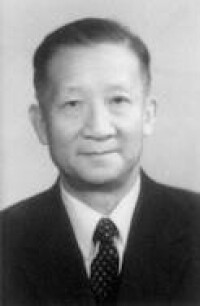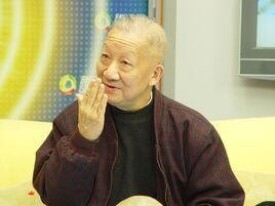吳新智
中國科學院院士
吳新智(1928年6月2日-2021年12月4日),男,安徽合肥人,漢族。古人類學家,中國科學院院士。
2021年12月4日19時40分,吳新智因病醫治無效,在北京逝世,享年93歲。
1928年6月2日,吳新智出生於安徽合肥,抗日戰爭時期,為了躲避戰亂一家人搬到了四川樂山腳下。12歲的吳新智開始了在鄉野村間的生活;

吳新智
1946-1947年在同濟大學新生院學習;
1947年進上海醫學院醫本科學習,1953年畢業;
1952-1953年在中央衛生部高級師資進修班進修解剖學;
1953-1957年任大連醫學院助教;
1957-1961年在中國科學院研究生院學習;
1961年畢業,以後歷任中國科學院古脊椎動物與古人類研究所助理研究員,副研究員,研究員,副所長;
1986年,被聘為博士生導師、獲得政府特殊津貼。
1999年當選中國科學院院士。
人物逝世
2021年12月4日19時40分,中國共產黨黨員、中國科學院院士、古人類學家,中國科學院古脊椎動物與古人類研究所研究員、原副所長,中國科學院大學榮譽講席教授吳新智同志因病醫治無效,在北京逝世,享年93歲。
他在1984年與兩位外國人類學家聯名提出現代人起源的多地區進化說,主張現今的四大人種分別起源於中國、非洲等四個地區,他們在各自的地區相對獨立地連續進化,互相間有一定程度的基因交流,使得全人類發展成一個多型種---智人。現在這個假說已成為世界上這個研究領域兩個影響最大的學說之一。他與同事總結了我國古人類的一系列共同的形態特徵,如面部和鼻樑扁平,眼眶呈長方形,上門齒呈鏟形等等。他還發現我國直立人與智人之間有形態鑲嵌的現象,維護了直立人的祖先地位。他研究我國古人類與境外人群之間的關係,發現基因交流在形態上的表現。他將現代人起源的多地區進化說涉及中國的部分擴展開來,於1998年為我國的人類進化提出新的假說:連續進化附帶雜交,主張中國古人類連續進化為主,使得在經過了一百多萬年相對獨立的進化后中國人還能保有與其他人群易於識別的形態特徵;與其他地區人群的雜交是少量的,但足以使中國人與其他人群能維繫在同一個物種內。他在發現湖北鄖西的直立人、河南淅川的直立人和智人以及山西丁村的智人化石的工作中起過重要的作用。他以發表著作,主辦訓練班,協助創立和運行‘人類學學報’等活動,在開創我國的靈長類形態學和法醫人類學以及推動、發展我國各民族的體質人類學研究的工作中都起過很重要的作用。
根據2020年4月中國科學院古脊椎動物與古人類研究所網站顯示,吳新智的代表作有《陝西大荔的早期智人古老類型的一個保存完好的頭骨》《中國漢族髖骨的性別差異和判斷》《長臂猿解剖》《中國人類的進化》(英文)和《20世紀的中國人類古生物學研究與展望》等。
1.《從頭骨復原面貌的原理》
2.《人體骨骼測量方法》
3.《遠古人類的家園 周口店北京猿人遺址》
4.《中國古人類遺址》
5.《人類進化足跡》
6.《人類的起源》
7.《人類進化足跡(2008)》
8.《中國體質人類學百年文選》
9.《探秘遠古人類》
他發表了80餘篇學術論文和專書(不含科普文章)其中20餘篇(冊)在國外發表。
1. 吳新智,畢初珍(1959)靈長類恆齒的出牙順序.古脊椎動物與古人類,1(2):92-93.
2. 吳汝康,吳新智,王存義(1959)中國猿人女性頭像的復原.古脊椎動物與古人類,1(3):147-150.
3. Woo Jukang, Wu Xinzhi, Wang Cunyi(1959) New reconstruction of physiognomy of Sinanthropus woman. PalAsiatica,3(3): 165-166.
4. 吳新智(1960)山頂洞人的種族問題.古脊椎動物與古人類,2(2):141-148.
5. 顏誾,吳新智,劉昌芝, 等(1960)西安半坡人骨的研究. 考古,(9):36-47.
6. 吳新智(1961)非洲新發現的“東非人”化石.古脊椎動物與古人類,(2): 168-171.
7. 吳新智(1961)周口店山頂洞人化石的研究.古脊椎動物與古人類,(3):181-231.
8. Wu Xinzhi(1961) On the racial types of the Upper Cave Man of Choukoudian. Scientia Sinica,10(8): 998-1005.
9. 吳新智,趙資奎,袁振興,等(1962)廣西東北地區調查簡報.古脊椎動物與古人類,6(4):408-413.
10. 吳新智,張銀運(1962)關於勞動.社會發生髮展的問題.古脊椎動物與古人類,7(4):370-375.
11. 吳汝康,吳新智(1965)人體骨骼測量方法.北京:科學出版社,1-92.
12. 吳新智,袁振新,韓德芬,等(1965)陝西藍田公王嶺猿人地點發掘報告.古脊椎動物與古人類,
13. 吳新智,宗冠福(1973)山東新太烏珠台更新世晚期人類牙齒和哺乳動物化石.古脊椎動物與古人類,11(1):103-106.
14. 吳新智(1978)廣東增城金蘭寺遺址新石器時代人類頭骨.古脊椎動物與古人類,(3):201-204.
15. 中國科學院古脊椎動物與古人類研究所,中國科學院昆明動物研究所(1978)長臂猿解剖.北京:北京科學出版社,1-163.(書內註明系吳新智,林一璞,葉智彰,徐慶華等的工作)
16. 吳新智,張銀運(1978)中國古人類綜合研究.見:古脊椎動物與古人類研究所編.古人類論文集.北京:科學出版社,28-42.
17. 吳汝康,吳新智,邱中郎,等(1978)人類發展史.北京:科學出版社,1-363.
18. 吳新智,邱中郎(1978)中國古人類及其年代.見:古脊椎動物與古人類研究所編.古脊椎動物.古人類及古文化古環境.39-47.
19. 吳新智,尤玉柱(1979)大荔人遺址的初步觀察.古脊椎動物與古人類,17(4):294-303.
20. 吳新智,周春茂(1979)大荔人及其文化.考古與文物(創刊號),2-6.
22. 吳汝康,吳新智,張森水,等(1980)坦尚尼亞肯亞古人類綱要.北京:科學出版社,1-169.
23. 吳新智(1981)中國大荔縣發現的早期智人古老類型的一個完好頭骨.中國科學,(2):200-206.
24. Wu Xinzhi(1981) A well preserved cranium of archaic type of early Homo sapiens from Dali, China. Scientia Sinica,24(4): 530-543.
25. 吳新智(1982)古人類學.見:自然雜誌編輯部編.自然科學年鑒(1982 年).上海:上海科學技術出版社,2.86-2.89.
26. 吳新智,邵興周,王衡(1982)中國漢族髖骨的性別差異和判斷.人類學學報,1(2):118-131.
27. 吳汝康,吳新智(1982)河南淅川的人類牙齒化石.古脊椎動物與古人類,20(1):1-9.
28. Wu Rukang, Wu Xinzhi(1982) Comparison of Tautavel Man with Homo erectus and early Homo sapiens in China. In: L’Homo Erectus et la Place de L’Homme de Tautavel Parmi les Hominides Fossiles. 1er Congres International de Paleontologie Humaine, Nice Prestige Vol.2.605-616. Nice: Louis-Jean.
29. 吳新智(1984) 關於舊石器時代的考古工作. 四川文物,(3):14-17.
30. 吳新智(1984)澳洲人.黑種人和白種人頭骨觀察.解剖學通報(增刊),7
31. 吳新智,張振標,丁細凡(1984)鎖骨的年齡變化.人類學學報,3(1): 30-31.
32. 吳新智,張振標,張建軍(1984)柳江化石智人的身高.人類學學報,3(3):210-211.
33. 吳汝康,吳新智,張振標(1984)人體測量方法.北京:科學出版社,1-172.
34. Wu Rukang, Wu Xinzhi(1984) Hominid fossils from China and their relation to those of neighboring regions. In: The Evolution of the East Asian Environment (2). Whyte P. et al. eds. Hong Kong: Centre of Asian Studies, University of Hong Kong.787-795.
35. Wolpoff MH, Wu XZ,Thorne AG(1984)Modern Homo sapiens origins: a general theory of hominid evolution involving the fossil evidence from East Asia. In: Smith F.H., and Spencer F., eds. The Origin of Modern Humans: A World Survey of the Fossil Evidence. New York: Liss.411-483.
36. Wu Xinzhi, Wang Linghong(1985) Chronology in Chinese Palaeoanthropology. In: Palaeoanthropology and Palaeolithic Archaeology in the People’s Republic of China. Wu Rukang and Olsen JW eds. Orlando:Academic Press, Inc.29-51.
37. Wu Xinzhi, Wu Maolin(1985) Early Homo sapiens in China. Ibid:91-106.
38. Wu Xinzhi, Zhang Zhenbiao(1985) Homo sapiens remains from Late Palaeolithic and Neolithic in China. Ibid:107-133.
39. 陳德珍,吳新智(1985)河南長葛石固早期新石器時代人骨的研究.人類學學報,4(3):205-214.
40. 陳德珍,吳新智(1985)河南長葛石固早期新石器時代人骨的研究(續).人類學學報,4(4):314-323.
41. 吳新智(1986)中國古人類研究的歷史與現狀.日本別府大學亞細亞研究所報,1-8(日文).
42. Wu Xinzhi(1986) Upper Palaeolithic man in China and his relation with populations of neighboring areas. In: The Pleistocene Perspective. Vol.1 Department of Archaeology, University of Southampton ed. Southampton: Allen and Unwin.
43. 吳新智,魏錫雲(1986)中國人與澳大利亞人的頦孔高度.人類學學報,5(2):128-129.
44. 吳新智,Brown P(1986)澳大利亞庫布爾溪更新世人骨的頦孔高度.人類學學報,5(4):314-316.
45. 吳新智(1987)中國晚舊石器時代人類與其南鄰(尼阿人及塔邦人)的關係.人類學學報,6(3):180-183.
46. 吳新智(1987)中國化石人類對澳大利亞人類進化的影響.見:中國科學院中澳第四紀合作研究組編.中國-澳大利亞第四紀學術討論會論文集.北京:科學出版社,246-250.
47. 吳新智(1988)中國與日本舊石器時代晚期人類的關係.人類學學報,7(3):235-238.
48. 吳新智(1988)中國和歐洲早期智人的比較研究.人類學學報,7(4):287-293.
50. 吳新智(1988)中國體質人類學的現狀和展望.中國解剖學會會訊,(4).
51. Wu Xinzhi(1988) China report-Palaeoanthropology. In: Whyte P. et al. eds. The Palaeoenvironment of East Asia from Mid-Tertiary, Proceedings of the Second Conference. Vol.2. Hong Kong University of Hong Kong.971-980.
52. Wu Xinzhi(1988) Human migration in East Asia and Australia during the Late Pleistocene. In: Whyte P et al. eds. The Palaeoenvironment of East Asia from Mid-Tertiary, Proceedings of the Second Conference. Vol.2. Hong Kong: University of Hong Kong.1069-1075.
53. 吳新智,趙忠義(1988)馬壩人頭像復原.見:廣東省博物館和曲江縣博物館編.紀念馬壩人化石發現三十周年文集.北京:文物出版社,43-44.
54. 吳新智(1989)中國的早期智人.見:吳汝康,吳新智,張森水主編.中國遠古人類.北京:科學出版社,24-41.
55. 吳新智(1989)雲南元謀近年發現的古猿化石.見:吳汝康,吳新智,張森水主編.中國遠古人類.北京:科學出版社,266-267.
56. 吳新智(1989)論中國古人類的連續發展.見:田昌五,石興邦主編.中國原始文化論集.北京:文物出版社,27-34.
57. 吳汝康,吳新智,張森水主編(1989)中國遠古人類.北京:科學出版社,1-437.
58. 吳新智(1990) 中國遠古人類的進化. 人類學學報,9(4):312-321.
59. Wu Xinzhi(1991) Human evolution and dispersal in East Asia. In: Institute of Vertebrate Paleontology and Paleoanthropology ed. Contributions to the XIII INQUA. Beijing: Beijing Publishing House of Science,15-20.
60. 吳新智(1991)東亞古人類的進化與擴布.見:古脊椎動物與古人類研究所編.參加第十三屆國際第四紀大會論文選.北京:北京科學技術出版社,15-20.
61. Wu Xinzhi(1991) Fossil humankind of China. In: Quarternary Geology and Environment in China. Liu TS ed. Beijing: Science Press.129-135.
62. Wu Xinzhi(1991) Continuité évolutive des hommes fossiles Chinois. In: Hublin J.J. et Tillier M.A. eds. Aux Origins d’Homo sapiens. Paris: Presses Universitaires de France.157-159.
63. 吳新智(1991)簡論中國人類進化的連續性與擴布.廣東文博,(1-2):4-7.
64. Wu Xinzhi(1992) Origins and affinities of the stone age inhabitants of Japan. In: Japanese As a Member of the Asian and Pacific Populations, International Symposium 4. Kyoto: International Research Center for Japanese Studies.1-8.
65. 吳新智(1992)古人類學.見:自然雜誌編輯部編.自然科學年鑒(1992 年).上海:上海翻譯出版社,3.17-3.20.
66. 吳新智(1992)黃種人祖先的探討.見:北京解剖學會四十周年論文集.北京:北京解剖學會,26-27.
67. Wu Xinzhi(1992) Origin of Homo sapiens in China. In: Korea Anthropology Institute et al. eds. Korea-China Quarternary Prehistory Symposium. Seoul.106-111.
68. Wu Xinzhi(1992) The origin and dispersal of anatomically modern humans in East Asia and Southeast Asia. In: The Evolution and Dispersal of Modern Humans in Asia. Akazawa T., Aoki K. and Kimura T. eds. Tokyo: Kokusen-sha.373-378.
69. Wu Xinzhi, Br.uer G(1993) Morphological comparison of archaic Homo sapiens crania from China and Africa. Zeitschrift für Morphologie und Anthropologie,79(3): 241-259.
70. 吳汝康,吳新智,張振標,等(1993)海南島少數民族人類學考察.北京:海洋出版社,1-112.
71. 吳新智(1994)中國和非洲古老智人顱骨特徵的比較.人類學學報,13(2): 93-103.
72. Wu Xinzhi(1994) New advances on the origin of anatomically modern humans in East Asia. In: Abstracts, XIV Federative International Congress of Anatomy (Lisbon). Department of Anatomy and of Histology and Embryology, New University of Lisbon, Faculty of Medical Sciences.211
73. Wu Xinzhi(1994) Pleistocene peoples of China and the peopling of the Americans In: Bonnichsen R. and Steele D.C. eds. Methods and Theory for Investigating the Peopling of the Americans. Oregon: Center for the Study of the First Americans, Oregon State University, Corvallis.73-78.
74. Wu Xinzhi(1995) The continuity of human evolution in East Asia. In: Brenner S. and Hanihara K. eds. The Origin and Past of Modern Humans As Viewed from DNA. Singapore: World Scientific Publishing Co,267-282.
75. Wu Xinzhi(1995) Morphological comparison between human skulls of middle Pleistocene from China and Europe. In: Bermudez et al. eds. Evolucion Humana En Europay Los Yacimientos De La Sierra De Atapuerca. Vol.1. Junta de Castilay Leon Consejeria de Culturay Turismo.243-248.
76. Wu Xinzhi, Poirier FE(1995)Human Evolution in China A Morphometric Description of Fossils and a Review of Sites. New York: Oxford University Press,1-317.
78. Wu Xinzhi(1996) The mosaic evolution of humankind in China. In: Bulletin of the Indo-Pacific Prehistory Association 15, Indo-Pacific Prehistory, The Chiang Mai Papers Vol.2. Glover I.C. and Bellwood P. eds.225-228.
79. Wu Rukang, Wu Xinzhi(1996) China, Hominid An Up-date. Orban R and Roels D. eds. Bruxelle: Lab. Anthropology and Human Genetics, Universite Libre Bruxelles.1-105.
80. 吳新智(1997) 柳江化石人髖骨的性別判斷. 人類學學報,16(2):107-111.
81. Wu Xinzhi(1997) On the descent of modern humans in East Asia. In: Conceptual Issues in Modern Human Origin Research.Clarke G.A. and Willermet C.M. eds. New York: Aldine de Gruyter.283-293.
82. Wu Rukang, Wu Xinzhi(1997) China. In: History of Physical Anthropology An Encyclopedia. Vol.1 Spencer F. ed. New York: Garland Publishing, Inc.273-282.
84. 吳新智(1998)人類起源研究新進展.見:張燾主編.科學前沿與未來.北京:科學出版社,161-181.
85. 吳新智(1998)從中國晚期智人顱牙特徵看中國現代人起源.人類學學報,17(4):276-282.
86. 吳新智(1998)應嚴肅對待前人和自己的科研成果(關於周口店第一地點用火證據的評論).人類學學報,322-324.
87. Grün R, Huang PH, Wu X, Stringer CB, Thorne AG, McCulloch M(1998) ESR analysis of teeth from paleoanthropological site of Zhoukoudian, China. Journal of Human Evolution.32(1): 83-91.
88. Wu Xinzhi(1999) Investigating the possible use of fire at Zhoukoudian, China. Science,283: 299.
89. 吳新智(1999)中國古人類化石研究對古人類學的貢獻.第四紀研究,(2):97-105.
90. 吳新智(1999)廿世紀的中國人類古生物學研究與展望.人類學學報,18(3):165-175.
91. 吳新智,黃慰文,祁國琴(1999)中國古人類遺址.上海:上海科技教育出版社,1-307.
92. 吳新智(2000)巫山龍骨坡似人下頜屬於猿類.人類學學報,19(1):1-10.
93. Wu Xinzhi(2002) Longgupo mandible belongs to ape. Acta Anthropologica Sinica 21(Supplement):19-24.
94. 吳新智(2000) 古人類學研究進展. 世界科技研究與發展,22(5):1-6.
95. 席煥久,吳新智(2000)中國人類學的發展——慶祝中國解剖學會成立80 周年.見:中國解剖學會編.中國解剖學八十年.40-46.
96.劉東生,施雅風,王汝建,趙泉鴻,翦如湣,成鑫榮,汪品先,王蘇民,袁寶印,吳新智,邱占祥,徐欽琦,黃萬波,黃慰文,安芷生,鹿化煜,(2000)以氣候變化為標誌的中國第四紀地層對比表.第四紀研究,20(2):108-128.
97. 吳新智(2001)對21 世紀發展中國人類起源研究的若干建議.第四紀研究,21(3):233-238.
98. 吳新智(2001)人類起源回顧與中國古人類學展望.地球科學進展,16(5):629-633.
99. 周文蓮,吳新智(2001)現代人頭面部某些特徵的橫斷柵相位法測量研究.人類學學報,20(2):81-92.
100.周文蓮,吳新智(2001)現代人頭面部幾項非測量性狀的觀察.人類學學報,20(4):288-294.
101.吳新智,尚虹(2002)中國直立人變異的初步研究.第四紀研究,22(1):20-25.
102.吳新智,劉武,尚虹(2002)人類進化足跡.北京:北京教育出版社,北京少年兒童出版社,1-144.
103.吳汝康,張銀運,吳新智(2002)人類頭骨——南京直立人1 號頭骨(第二章,第一節).見:吳汝康等主編.南京直立人.南京:江蘇科學技術出版社,36-67,361-273.
104.尚虹,吳新智,張振標,席煥久(2002)人類頭骨——南京直立人1 號頭骨古病理學的初步探討(第二章,第二節).見:吳汝康等主編. 南京直立人. 南京: 江蘇科學技術出版社,68-70,274-275.
105.尚虹,吳新智(2002)人類頭骨——南京直立人2 號頭骨(第二章,第三節).見:吳汝康等主編.南京直立人.南京:江蘇科學技術出版社,70-80,275-278.
106.吳新智(2003)德日進在中國古人類學的創建時期.第四紀研究,23(4):362-365.
107.Wu Xinzhi(2004) On the origin of modern humans in China. Quaternary International,117: 131-140.
108.Wu Xinzhi(2004) Fossil humankind and other anthropoid Primates of China. International Journal of Primatology,25(5): 1093-2004
109.吳新智(2004)新標本和新信息的積累促進對中國人類進化模式的思考.紀念裴文中教授百年誕辰論文集(人類學學報,23卷增刊),92-98.
110.吳新智(2004)關於中國現代人起源的研究.嶺南考古研究,4:3-8.
111.Wu Xinzhi(2005) The role played by archaeology in the construction of China. Centre for Archaeological Research Malaysia, Malaysia Science University.
112.Wu Xinzhi(2005) Palaeoanthropological and molecular studies on the origin of modern humans. Transactions of the Royal Society of South Africa.60(2): 115-119.
113.吳新智(2005)與中國現代人起源問題有聯繫的分子生物學研究成果的討論.人類學學報,24(4):259-269.
114.吳新智(2005)再議中國現代人起源的研究.嶺南考古研究,5:1-7.
115. 吳新智(2006) 中國古人類進化連續性新辯. 人類學學報,25(1):17-25.
116.吳新智(2007)現代人起源的多地區進化學說在中國的實證. 第四紀研究,26(5):702-709.
117.尚虹,劉武,吳新智,董光榮(2007)薩拉烏蘇更新世晚期的人類肩胛骨化石.科學通報,51(8):937-941.
118.吳新智,尚虹(2007)南京直立人的高鼻樑是由於對寒冷氣候的適應嗎?人類學學報,26(4):289-294.
119.吳新智(2008)再論南京直立人高鼻樑的成因.人類學學報,27(3):191-199.
120. 吳新智(2009) 大荔顱骨的測量研究. 人類學學報,28(3):217-236.
121.杜靖,吳新智(2009)中國古人類化石的主要發現和理論探索(1922-2009).古生物學報,(3):302-313.
122.吳新智,杜靖(2010)吳汝康人類學實踐中的人觀思想及其來源.青海民族研究(社會科學版),(2):12-18.
123.高星,張曉凌,楊東亞,沈辰,吳新智(2010)現代中國人起源與人類演化的區域性多樣化模式. 中國科學: 地球科學,40(9):1287-1300.
124.Wu Xinzhi, Cui Yaming(2010) On the origin of modern humans in China. Before Farming(online), 2010(4) article,6: 1-6.
125.Liu W, Jin CZ, Zhang YQ, Cai YJ, Xing S, Wu XJ, Cheng H, Edwards RL, Pan WS, Qin DG, An ZS, Trinkaus E, Wu XZ(2010) Human remains from Zhirendong, South China, and modern human emergence in East Asia. Proceedings of the National Academy of Sciences,107(45): 19201-19206.
126.Zhao LingXia, Zhang LiZhao, Zhang FuSong, Wu XinZhi(2011) Enamel carbon isotope evidence of diet and habit of Gigantopithecus blacki and associated mammalian megafauna in the Early Pleistocene of South China. Chinese Science Bulletin,56(33): 3590-3595.
127.劉武,金昌柱,吳新智(2011)廣西崇左木欖山智人洞10 萬年前早期現代人化石的發現與研究.中國基礎科學,1:11-14.
128. 吳新智(2012)Human evolution in China Viewed from multidisciplinary records. In Peter Nas, Hao Shiyuan and Zhang Xiaomin eds. Keynotes in Anthropology.國際人類學與民族學聯合會第十六屆大會主旨發言.名家講座.北京:知識產權出版社,13-21.
129.胡榮,趙凌霞,吳新智(2012)華南化石猩猩牙齒的芮氏線生長周期.科學通報,6:448-452.
130.Wu Xinzhi, Athreya Sheela(2013) A Description of the Geological Context, Discrete Traits, and Linear Morphometrics of the Middle Pleistocene Hominin from Dali, Shaanxi Province, China. American Journal of Physical Anthropology,150:141–157.
131.Rosenberg KR, Wu Xinzhi(2013) A River Runs through It: Modern Human Origins in East Asia. The Origins of Modern Humans: Biology Reconsidered, Chapter 3, Edited by Fred H. Smith and James C. M. Ahern.89-122.
132.Wu Xinzhi and Xu Xin(2013). Human Origins in China. Oxford Bibliographies.
http://www.oxfordbibliographies.com/ 29-Aug-2013.
133.吳新智(2014). 第三編第四章人類化石. 王益人編. 丁村舊石器時代遺址群——丁村遺址群1976-1980年發掘報告. 北京:科學出版社, 49-53.
134.吳新智(2014). 丁村人類化石的意義. 中國文物報, 2014-10-17.
135.吳新智(2014). 大荔顱骨在人類進化中的位置. 人類學學報, 2014, 33(4): 405-426.
136.Maohua Zhong, Congling Shi, Xing Gao, Xinzhi Wu, Fuyou Chen, Shuangquan Zhang, Xingkai Zhang, John W. Olsen(2014). On the possible use of fire by Homo erectus at Zhoukoudian, China. Chinese Science Bulletin, 2014, 59(3): 335-343.
137.吳新智(2015). 人類進化過程階段劃分新見解. 化石, (1): 41-42.
138.吳新智, 同號文(2015). 關於澎湖1號下頜骨化石意義和年代的討論. 人類學學報, 34(3): 1-7.
139.吳新智,徐欣(2015). 探秘遠古人類. 外語教學與研究出版社.
140.吳新智(2015). 尋找現代人的祖先. 百科知識, 12B: 4-10.
141.Yaming Cui, Xinzhi Wu(2015). A geometric, morphometric study of a Middle Pleistocene cranium from Hexian, China. Journal of Human Evolution, 88: 54-69.
根據2020年4月中國科學院古脊椎動物與古人類研究所網站顯示,吳新智先後獲得國家科學技術進步二等獎,中國科學院自然科學一等獎、郭沫若中國歷史學獎二等獎。1990年獲選中國科學院優秀研究生導師。1991年獲中國科學院自然科學獎一等獎。
1999年當選中國科學院院士。
2013年獲人類學終身成就獎“金琮獎”,以表彰他在中國乃至世界古人學研究領域作出的傑出貢獻。
2019年11月18日,被中國古生物學會授予終身成就榮譽。
講座報告
2012年5月13日,吳新智應鄭州市文物考古研究院之邀,以《從我們的祖先到我們》為題深入淺出、圖文並茂地為全體職工解讀了人類的起源。
曾任中國解剖學會常務理事、副理事長、人類學專業委員會主任、中國古生物學會榮譽理事等,現任中國解剖學會名譽理事長、《人類學學報》主編、中國大百科全書(第二版)人類學主編。他還兼任廣西醫科大學名譽教授。
吳新智在中國乃至世界古人學研究領域作出了傑出貢獻。(中國科學院古脊椎動物與古人類研究所評)
吳新智院士是世界有關現代人起源兩大學說之一的主要創立者,在古人類研究領域享有崇高聲譽。(鄭州市文物考古研究院評)
